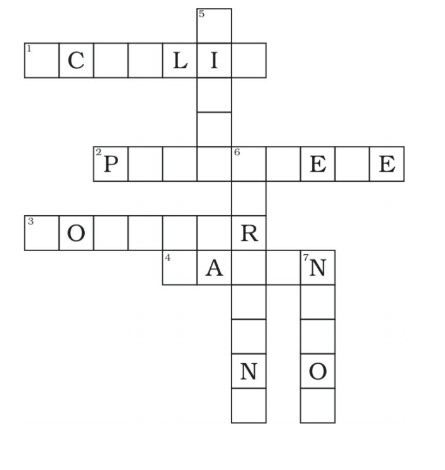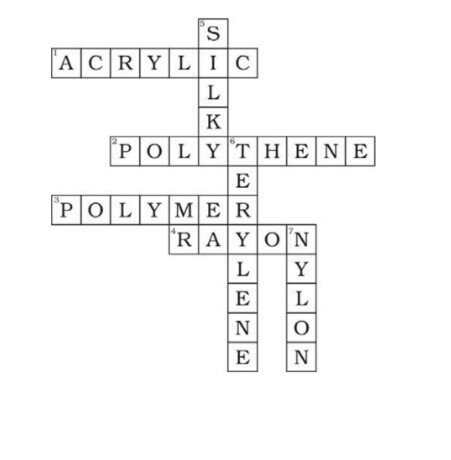Science
(www.olympiadsuccess.com)
Chapter 3: Synthetic Fibres and Plastics
Class: VIII
Exemplar Solutions
MULTIPLE CHOICE QUESTIONS
Question 1.
Pick the synthetic fibre out of the following?
(a) Cotton (c) Jute
(b) Nylon (d) Wool
Answer 1 (b)
Question 2. Which of the following is a source of rayon?
(b) PET (d) Silk
Answer 2 (c)
Question 3. Polycot is obtained by mixing
(a) nylon and wool (c) nylon and cotton
(b) polyester and wool (d) polyester and cotton
Answer 3 (d)
Question 4. Which is a thermosetting plastic?
(a) Melamine (c) PVC
(b) Polythene (d) Nylon
Answer 4 (a)
Question 5. The material similar to silk in appearance is
(a) Nylon (c) Polyester
(b) Rayon (d) Terylene
Answer 5 (b)
Question 6. The most suitable material for the preparation of handles of cooking utensils is (a) Polythene (c) Nylon
(b) PVC (d) Bakelite
Answer 6 (d)
Question 7. Which of the following is not a common property of plastics?
(a) Non-reactive (c) Durable
(b) Light in weight (d) Good conductor of electricity
Answer 7 (d)
Question 8. Which of the following represents the correct match for items in Column A with those in Column B.?
Column A Column B
(a) I-(ii), II-(iii), III-(i) (c) I-(ii), II-(i), III-(iii)
(b) I-(iii), II-(i), III-(ii) (d) I-(iii), II-(ii), III-(i)
Answer 8 (b)
Question 9. Which of the following groups contain all synthetic substances?
(a) Nylon, Terylene, Wool (c) PVC, Polythene, Bakelite
(b) Cotton, Polycot, Rayon (d) Acrylic, Silk, Wool
Answer 9 (c)
Question 10. The material which is commonly used for making kitchen containers is
(b) Acrylic (d) PET
Answer 10 (d)
VERY SHORT ANSWER QUESTIONS
Question 11. Cotton is a natural polymer. What is its chemical name?
Answer 11. Cellulose.
Question 12. A synthetic fiber which looks like silk is obtained by chemical treatment of wood pulp. It is, therefore, known as artificial silk. What is its common name?
Answer 12. Rayon.
Question 13. Terrycot is made by mixing two types of fibres. Write the names of the fibres.
Answer 13. Terylene and cotton.
Question 14. Plastic articles are available in all possible shapes and sizes. Can you tell why?
Answer 14. Plastic articles are available in all possible shapes and sizes because it is easily to mouldable.
Question 15. Plastic is used for making a large variety of articles of daily use and these articles are very attractive. But it is advised to avoid the use of plastic as far as possible. Why?
Answer 15. Due to its non-biodegradable nature it causes environmental pollution.
Question16. Why is it not advisable to burn plastic and synthetic fabrics?
Answer 16. Burning of plastic and synthetic fabrics produces lots of poisonous gases causing air pollution.
Question 17. Select the articles from the following list which are biodegradable.
(a) paper (c) wood
(b) woolen clothes (d) aluminium can
(e) plastic bag (f) peels of vegetables
Answer 17. (a), (b), (c) and (f)
Question 18. A bucket made of plastic does not rust like a bucket made of iron. Why?
Answer 18. Plastic is a non-reactive material. It does not react with air and water and thus does not rust.
SHORT ANSWER QUESTIONS
Question 19. Rohit took with him some nylon ropes, when he was going for rock climbing. Can you tell why he selected nylon ropes instead of ropes made of cotton or jute?
Answer 19. Nylon ropes are strong, elastic and lighter as compared to cotton and jute ropes.
Question 20. A lady went to the market to buy a blanket. The shopkeeper showed her blankets made of acrylic fibres as well as made of wool. She preferred to buy an acrylic blanket. Can you guess why?
Answer 20. Acrylic blankets are cheap, light in weight, more durable and are available in variety of colours and designs. They can be easily washed at home.
Question 21. PVC (polyvinyl chloride) is a thermoplastic and is used for making toys, chappals, etc. Bakelite is a thermosetting plastic and is used for making electrical switches, handles of various utensils, etc. Can you write the major difference between these two types of plastics?
Answer 21. Thermoplastics get deformed easily on heating and can be bent easily on heating. On the other hand thermosetting plastics when molded once cannot be softened on heating.
Question 22. Fill in the blanks.
Answer 22.
Question 23. Match items in List A with the items of list B.
List A List B
(a) nylon (i) non-stick coating
(b) PET (ii) electric switches
(c) rayon (iii) parachutes
(d) thermosetting plastics (iv) polyester
(e) teflon (v) artificial silk
Answer 23.
(a)-(iii), (b)-(iv), (c)-(v), (d)-(ii), (e)-(i)
Question 24. Unscramble the jumbled words given below, related to synthetic materials.
(a) anory (b) lopmery
(c) relyteen (d) laspict
(e) yespolter (f) felton
Answer 24.
(a) rayon (d) plastic
(b) polymer (e) polyester
(c) terylene (f) Teflon
LONG ANSWER QUESTIONS
Question 25. Indicate whether the following statements are True or False. Also write the false statements in their correct form.
Answer 25.
Question 26. Write the importance of synthetic polymers in our life.
Answer 26. Hint: Write uses of synthetic polymers like nylon, acrylic, terylene, PET, plastics, etc.
Question 27. Despite being very useful it is advised to restrict the use of plastic. Why is it so? Can you suggest some methods to limit its consumption?
Answer 27. Hint: Plastic is a non-biodegradable material and as such it causes land pollution. At the same time burning such materials in the form of garbage causes serious air pollution.
Reducing it’s use, reusing it for some other purpose and recycling may limit its overall consumption and reduce environmental pollution.
Question 28. Write an activity to show that synthetic fibres are stronger than the cotton fibres.
Answer 28. Hint: By hanging weight with the threads of same thickness of any synthetic fibre and cotton separately will show that more weight is required to break a synthetic thread. (Also see activity 3.1 of NCERT science book of class VIII).
Question 29. Complete the crossword given below with the help of clues.

Across
Down
Answer 29.

Yearlong program for Olympiads preparation & to build necessary skills for future.
Explore More
Time to mark your calendar with the upcoming Olympiads exam schedule.
Explore More
Take your Olympiad preparation to next-level by taking LIVE Classes.
Explore More
Assess your performance by taking topic-wise and full length mock tests.
Explore More
Online tuitions for international compeitions like SASMO, SEAMO, etc for Grades 1-11.
Explore More